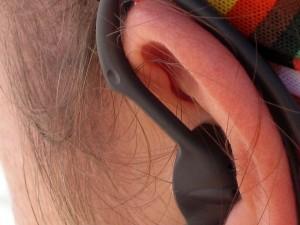 One of the most common complaints this holiday season is the added noise that assaults our ears.
One of the most common complaints this holiday season is the added noise that assaults our ears.But it is not just those bothersome Who’s in Whoville, or other holiday revelers and advertisers, but our everyday world has become a noisy place, especially in the city. Unfortunately, you can do just as much damage to your hearing by trying to isolate yourself. The use of earphones and earbuds has been growing over the past few decades, but such devices must be used carefully lest you subject your ears to the same torture a noisy truck would cause in the street – or worse! So how can you properly protect your hearing from the noise in your environment, and prevent a headache from excessive holiday noise? We reached out to Sarinne Fox of NoiseHelp.com. Sarinne’s website provides information, advice, and recommendations for dealing with the noise in your life. Whether you want in depth scientific explanations or just a product recommendation for getting better sleep, Sarinne has compiled a comprehensive source for finding more quiet in your life. We asked Sarinne some questions about her site and her work, and she obliged is with an interview. Goedeker’s: How did you get started in addressing the problem of excessive noise and noise pollution? Sarinne: It’s really something I’ve been aware of all my life, in the sense that sounds — whether “good” or “bad” — have a huge influence on my state of mind. I think a lot of people can relate to that! We deliberately use music to help modulate our moods, to experience a wide range of different emotions, to share in what other people are experiencing. And we feel annoyance, frustration, or maybe even rage when we are involuntarily subjected to noise, when it interrupts the flow of our thoughts or experience. But what I’ve learned only recently is that the influence of sound or noise is more fundamental than that. Beyond evoking feelings of happiness or annoyance, sound affects our whole body and mind. It produces physiological changes and affects our health and even our life span. Becoming aware of this gave me even more reason to pay attention to the sounds I surround myself with. It felt worth the effort to reduce the unwanted noises and invite more of the kinds of sounds that make my life better in some way. There is quite a bit of information on the internet about noise and its effects, and a lot of it has to do with the direct effect loud noise has on hearing — noise-induced hearing loss and tinnitus. These are extremely important, and it’s great that awareness is spreading! In the area of noise annoyance, the kind that isn’t deafeningly loud, there are a lot of websites and organizations where people can band together to try to reduce specific causes of noise pollution, usually through regulation or economic pressure. It’s great to see people working to change things for the long term, but at the same time people also need ways they can deal with noise problems they have right now, and that’s where I hope my Noise Help website has a contribution to make. My background being in both music and engineering, I felt I could bring together information that is scattered around in all sorts of places, and put it out there in a way that’s accurate and clear, and also helpful for an individual looking for ways to reduce noise or its effects. Part of the negative effect of noise is due to the feeling of helplessness, the feeling there’s nothing you can do to shut out the noise. So just with the realization that there are things you can do to protect yourself, that you’re not helpless, right there you’ve already taken a step in reducing noise’s impact on you. Goedeker’s: Do you think technology has made noise more or less of a problem in our modern lives? Sarinne: Certainly technology makes it possible to have more machines and noisier machines, and it’s done that! Industrial machines and motor vehicles and other transportation systems are major causes of noise pollution worldwide. On the other hand, it’s also technology that gives us ways to make machines quieter, and quiet technologies are being incorporated more and more into vehicles, tools, and appliances. This usually adds to the cost, so sometimes we have to pay more if we want a quieter model of a certain machine. Technology also brings us new tools we can use to control the level of noise in our lives. Ear plugs have been around since humans discovered beeswax, but new products are continually being invented that give us more or better or cheaper ways to reduce the level of noise that reaches our eardrums. There’s a quote from 1912, by Havelock Ellis: ”The sanitary and mechanical age we are now entering makes up for the mercy it grants to our sense of smell by the ferocity with which it assails our sense of hearing.” So people who lived through that change bore witness to the increase in noise it produced. I wasn’t around before the mechanical age, but I’m not sure I’d want to have to choose between obnoxious noises and horrible smells! Goedeker’s: Your advice and posts have a lot of references to the decibel levels. What are some rules of thumb for recognizing dangerous levels of sound without a device to measure the level? Sarinne: Great question! One reason that the rules can seem fuzzy is that it’s not just the decibel level that determines how harmful a noise is, it’s also how long you are exposed to it. A somewhat high noise level that’s OK for 15 minutes might cause damage if you stay exposed to it for an hour.
 One good rule of thumb if you’re in a noisy place is: If you’re talking to someone an arm’s length away from you and you have to raise your voice to be understood, it’s loud enough to do damage to your hearing over time. Similarly, if you’re listening to music through earbuds and you can’t understand someone who’s talking to you in a normal tone of voice from an arm’s length away, your ears are in the danger zone.
Another way to tell is if you ever notice a dullness in your hearing or a ringing in your ears after some noise exposure, say after going to a loud concert or using noisy equipment. In most cases your hearing will recover by itself after an isolated episode, but if it happens too often, hearing damage accumulates and can become permanent. So think of it as a warning sign telling you that whatever caused that temporary hearing problem, that situation is dangerously loud and you should avoid it in the future, or else wear ear plugs or other hearing protection.
Goedeker’s: What are some inexpensive ways anyone can reduce excessive noise in their homes?
Sarinne: Around the home, one of the most common sources of sound that’s loud enough to be dangerous to your hearing is headphones or earphones. It’s easy to overlook music as a source of “noise” because it’s a sound we want and we choose to listen to it, but it’s easy to turn the volume up to levels that will hurt your hearing over time. Keeping the volume down will help preserve your hearing, especially if you use them for more than an hour a day. If you have young children who use headphones, you can get a volume limiter for under $10 that will keep the volume from going over a safe level. With teenagers, the risk of hearing loss probably doesn’t loom high on their list of worries, but the thought of getting permanent tinnitus (non-stop ringing in the ears) can be a motivation for them to choose safer listening levels at least some of the time. Talk to your kids about it; make sure they’re aware.
Another common source of dangerously loud noise at home is power tools, such as yard equipment and woodworking tools. Wear ear plugs or earmuff-style hearing protectors when you use noisy power tools.
In fact, an excellent all-around tip is to keep a supply of ear plugs handy, so they’re always there if you need them. Ear plugs are one of the all-time best bargains around — they cost as little as 25 cents a pair, or even less in bulk; they’re compact and easy to carry with you; and they are very, very good at blocking out noise. They work for both the dangerously loud kind of noise and the annoying kind of noise that you’d just rather not have to put up with.
Another all-purpose technique for dealing with annoying noises is to mask them with white noise or some other smooth, featureless sound, such as the sound of a fan, or even radio static. What? Reduce noise by adding to it — How does that make sense? Well, yes, in this case you’re adding to the total sound (and for this reason you never want to use it in a truly loud environment), but the white noise covers up all the little noises that are so noticeable in a quiet environment, and keeps your mind from latching on to them. By adding a layer of white noise, you’re actually reducing the total noticeable noise. It’s a great solution if noises make it hard to get to sleep. You can buy special-purpose white-noise machines, and they’re very nice, but you can also find plenty of great sources online that are free that you can play through your web browser, MP3 player, or smartphone.
Each home has its own sources of noise, and different noises are bothersome to different people. To make your home a more comfortable place to be sound-wise, take the time to notice whenever you hear a sound that bothers you, whether it’s cupboard doors slamming, the dog’s dog tags jangling, or a squeaky hinge, and see if you can find a way to address it. Glue a bit of cork on the cupboard doors; get a noiseless collar tag for your dog; oil the squeaky hinge. Granted, some noises won’t be so easy to address, but you might be surprised how much more relaxing your home feels if you can eliminate a few niggling little noises that you hear over and over.
Find out more about the noise in your life and how to safely limit it at NoiseHelp.com.
One good rule of thumb if you’re in a noisy place is: If you’re talking to someone an arm’s length away from you and you have to raise your voice to be understood, it’s loud enough to do damage to your hearing over time. Similarly, if you’re listening to music through earbuds and you can’t understand someone who’s talking to you in a normal tone of voice from an arm’s length away, your ears are in the danger zone.
Another way to tell is if you ever notice a dullness in your hearing or a ringing in your ears after some noise exposure, say after going to a loud concert or using noisy equipment. In most cases your hearing will recover by itself after an isolated episode, but if it happens too often, hearing damage accumulates and can become permanent. So think of it as a warning sign telling you that whatever caused that temporary hearing problem, that situation is dangerously loud and you should avoid it in the future, or else wear ear plugs or other hearing protection.
Goedeker’s: What are some inexpensive ways anyone can reduce excessive noise in their homes?
Sarinne: Around the home, one of the most common sources of sound that’s loud enough to be dangerous to your hearing is headphones or earphones. It’s easy to overlook music as a source of “noise” because it’s a sound we want and we choose to listen to it, but it’s easy to turn the volume up to levels that will hurt your hearing over time. Keeping the volume down will help preserve your hearing, especially if you use them for more than an hour a day. If you have young children who use headphones, you can get a volume limiter for under $10 that will keep the volume from going over a safe level. With teenagers, the risk of hearing loss probably doesn’t loom high on their list of worries, but the thought of getting permanent tinnitus (non-stop ringing in the ears) can be a motivation for them to choose safer listening levels at least some of the time. Talk to your kids about it; make sure they’re aware.
Another common source of dangerously loud noise at home is power tools, such as yard equipment and woodworking tools. Wear ear plugs or earmuff-style hearing protectors when you use noisy power tools.
In fact, an excellent all-around tip is to keep a supply of ear plugs handy, so they’re always there if you need them. Ear plugs are one of the all-time best bargains around — they cost as little as 25 cents a pair, or even less in bulk; they’re compact and easy to carry with you; and they are very, very good at blocking out noise. They work for both the dangerously loud kind of noise and the annoying kind of noise that you’d just rather not have to put up with.
Another all-purpose technique for dealing with annoying noises is to mask them with white noise or some other smooth, featureless sound, such as the sound of a fan, or even radio static. What? Reduce noise by adding to it — How does that make sense? Well, yes, in this case you’re adding to the total sound (and for this reason you never want to use it in a truly loud environment), but the white noise covers up all the little noises that are so noticeable in a quiet environment, and keeps your mind from latching on to them. By adding a layer of white noise, you’re actually reducing the total noticeable noise. It’s a great solution if noises make it hard to get to sleep. You can buy special-purpose white-noise machines, and they’re very nice, but you can also find plenty of great sources online that are free that you can play through your web browser, MP3 player, or smartphone.
Each home has its own sources of noise, and different noises are bothersome to different people. To make your home a more comfortable place to be sound-wise, take the time to notice whenever you hear a sound that bothers you, whether it’s cupboard doors slamming, the dog’s dog tags jangling, or a squeaky hinge, and see if you can find a way to address it. Glue a bit of cork on the cupboard doors; get a noiseless collar tag for your dog; oil the squeaky hinge. Granted, some noises won’t be so easy to address, but you might be surprised how much more relaxing your home feels if you can eliminate a few niggling little noises that you hear over and over.
Find out more about the noise in your life and how to safely limit it at NoiseHelp.com.

